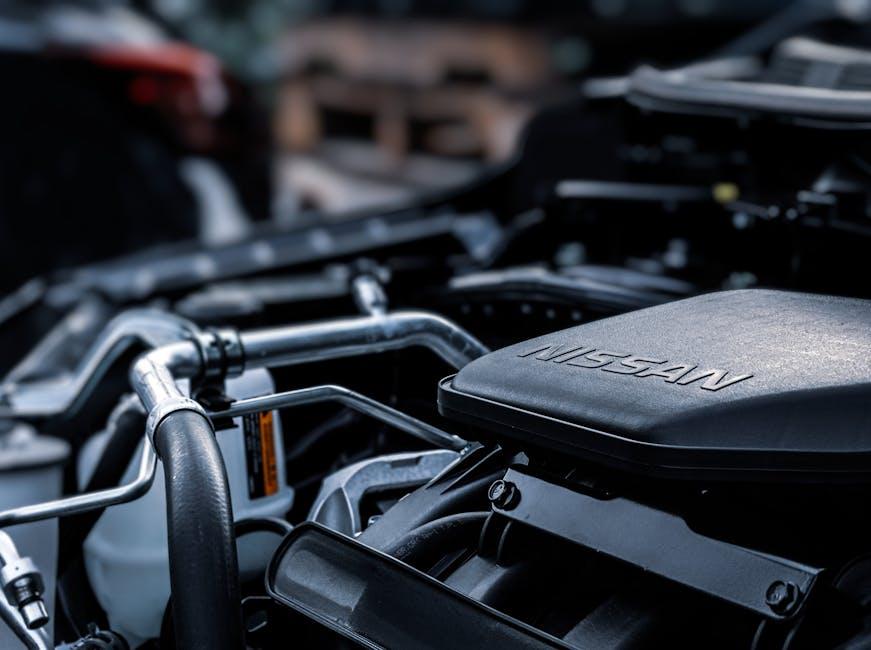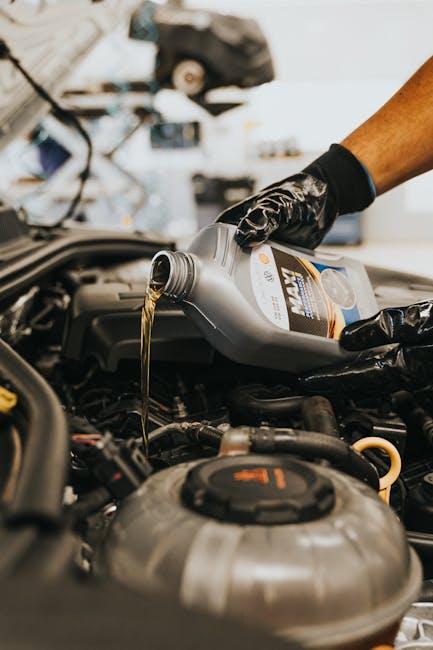A humming engine is the heart of any vehicle, and keeping it well-lubricated is essential for smooth performance and longevity. Among the many routine tasks that ensure your car runs optimally, topping up engine oil stands out as both simple and critical. Whether you’re a seasoned driver or a curious novice, understanding how to properly add engine oil can save you time, money, and potential mechanical headaches down the road. This guide will walk you through the essentials of topping up engine oil, empowering you to maintain your vehicle with confidence and care.
Table of Contents
- Choosing the Right Engine Oil for Your Vehicle
- Preparing Your Car for an Oil Top Up
- Step-by-Step Guide to Adding Engine Oil Safely
- Common Mistakes to Avoid When Topping Up Engine Oil
- How to Check Engine Oil Levels Accurately
- Maintenance Tips for Prolonging Engine Oil Life
- Q&A
- To Conclude

Choosing the Right Engine Oil for Your Vehicle
Picking the perfect engine oil is more than just grabbing the first bottle off the shelf. Vehicles demand specific oil viscosities and formulations to perform at their best. When deciding, consider your manufacturer’s recommendations which cover the necessary viscosity grades, like 5W-30 or 10W-40, as well as the oil type—whether conventional, synthetic blend, or full synthetic. Each type caters to different driving conditions and engine requirements, offering benefits like improved fuel efficiency, enhanced engine protection, or extended oil change intervals.
- Viscosity: Thickness matters; it affects engine start-up and operating temperature fluidity.
- Additives: Boost engine cleanliness and performance through detergents and antioxidants.
- Oil Classification: API ratings and manufacturer approvals ensure compatibility and warranty coverage.
| Oil Type | Best For | Common Viscosity |
|---|---|---|
| Conventional | Routine driving & older cars | 10W-30 |
| Synthetic Blend | Moderate performance & varied climates | 5W-30 |
| Full Synthetic | High performance & extreme temperatures | 0W-20, 5W-30 |

Preparing Your Car for an Oil Top Up
Before you begin topping up your engine oil, ensure your car is on a flat, level surface and the engine is cool. This minimizes the risk of burns and allows the oil to settle, giving a more accurate reading. Open the hood carefully and prop it securely. Locate the dipstick, usually marked with a bright handle, and remove it to check the current oil level. Wipe it clean, reinsert it fully, then pull it out again to see where the oil level falls. This step is crucial to avoid overfilling and to verify that topping up is necessary.
Gather all essential tools and supplies within reach to streamline the process. Here’s a quick checklist to keep handy:
- Correct engine oil type (refer to your owner’s manual)
- Funnel to avoid spills
- Clean rag for any drips
- Gloves for cleanliness and safety
- Flashlight for better visibility if needed
| Oil Grade | Recommended for | Viscosity |
|---|---|---|
| 5W-30 | Modern gasoline engines | Medium |
| 10W-40 | Older engines | Thicker |
| 0W-20 | Fuel-efficient cars | Thin |
Taking these preparatory steps ensures a smooth, safe experience and helps maintain your vehicle’s performance and longevity.

Step-by-Step Guide to Adding Engine Oil Safely
To begin, ensure your vehicle is parked on a level surface and the engine is cool to prevent burns or inaccurate oil level readings. Open the hood and locate the oil filler cap, usually labeled with an oil can symbol. Before pouring in any oil, check the current level using the dipstick by pulling it out, wiping it clean with a cloth, reinserting it fully, and then removing it again to read the level. This helps you determine exactly how much oil to add without overfilling.
When ready to top up, choose the right type and grade of oil specified in your vehicle’s manual and pour slowly. Use a clean funnel to avoid spills and contamination. After adding a small amount, wait a moment and recheck the oil level using the dipstick. Repeat the topping up in small increments until the oil reaches the recommended level but never surpasses the maximum mark. Always tighten the oil filler cap securely once done.
- Check the oil level before adding more
- Use the correct oil type for your engine
- Add oil gradually, avoiding overfill
- Keep the filler cap tightly sealed
| Step | Action | Tip |
|---|---|---|
| 1 | Park on level ground and cool engine | Prevents inaccurate readings |
| 2 | Locate and clean dipstick | Ensures precise measurement |
| 3 | Slowly add oil with a funnel | Avoids spills and overfill |
| 4 | Recheck oil level frequently | Prevents engine damage |

Common Mistakes to Avoid When Topping Up Engine Oil
When topping up engine oil, one of the most frequent missteps is using the wrong oil grade. Consult your vehicle’s manual to ensure compatibility, as oils vary in viscosity and additives—choosing the incorrect one can hinder engine performance or cause long-term damage. Additionally, many neglect to wipe the dipstick clean before checking oil levels, leading to inaccurate readings. Always clean the dipstick with a lint-free cloth before reinserting it for a proper measurement.
Another common error is overfilling the engine oil. While it might seem beneficial to add more, too much oil can create excessive pressure, leading to leaks and damage to seals. To avoid this, add oil gradually and recheck levels frequently. Also, refrain from topping up immediately after driving; the oil expands with heat and can give a false high reading. Ideally, check and add oil when the engine is cool, ensuring precise and safe replenishment.
| Common Mistake | Potential Issue | Tip to Avoid |
|---|---|---|
| Wrong Oil Grade | Engine wear and inefficiency | Always use manufacturer-recommended oil |
| Ignoring Dipstick Cleaning | Inaccurate oil level readings | Wipe dipstick before checking |
| Overfilling Oil | Seal damage and leaks | Add oil slowly, check frequently |
| Checking Oil When Hot | False high readings | Check oil when engine is cool |

How to Check Engine Oil Levels Accurately
To obtain an accurate reading, always start by parking your car on level ground and turning off the engine. Allow it to cool down for at least 10 minutes – this lets the oil settle and prevents a misleading measurement caused by hot, circulating oil. Next, locate the dipstick, usually marked with a bright handle, and pull it out completely. Wipe the dipstick clean with a lint-free cloth or paper towel to remove any residual oil, then reinsert it fully back into its tube. Pull it out once more to check the oil level against the marked indicators, usually labeled MIN and MAX. If the oil falls below the minimum line, it’s time to add more.
Keep in mind these tips for precision:
- Do not estimate the level; always use the dipstick’s actual markings.
- Check your oil regularly, especially before long trips or after hot months.
- Note the oil’s color and consistency; a milky or gritty texture may indicate contamination.
| Dipstick Indicator | Meaning | Action Needed |
|---|---|---|
| Below MIN | Oil level too low | Add engine oil immediately |
| Between MIN and MAX | Optimal oil level | No action required |
| Above MAX | Too much oil | Drain excess to avoid engine damage |

Maintenance Tips for Prolonging Engine Oil Life
To maximize the lifespan of your engine oil, consistency and precision are key. Regularly check your oil levels using the dipstick, ideally every couple of weeks, to catch low oil early and avoid engine strain. Always top up with the exact grade recommended by your vehicle manufacturer to maintain optimal performance and chemical stability. Using high-quality oil filters when changing or topping off oil helps trap impurities, preventing sludge buildup that can severely diminish oil life.
Adopting a routine maintenance schedule ensures your engine runs smoothly and extends oil longevity. Consider these simple habits:
- Warm up the engine briefly before driving to stabilize oil viscosity.
- Avoid frequent short trips that don’t allow oil to reach operating temperature.
- Monitor for leaks and address them promptly to prevent oil contamination or loss.
- Use synthetic oils if suitable, as they often resist breakdown better than conventional oils.
| Maintenance Task | Recommended Frequency |
|---|---|
| Oil Level Check | Every 2 Weeks |
| Full Oil Change | Every 5,000 – 7,000 Miles |
| Use of Quality Oil Filter | With Every Oil Change |
| Engine Warm-Up | Before Every Drive |
Q&A
Q&A: How to Top Up Engine Oil
Q1: Why do I need to top up my engine oil?
A1: Engine oil lubricates and cools your engine’s moving parts, preventing wear and overheating. Over time, oil levels drop due to consumption and minor leaks. Topping up ensures your engine runs smoothly and prolongs its life.
Q2: How do I know when it’s time to top up the oil?
A2: Check your oil level regularly using the dipstick—typically once a month or before a long trip. If the level is below the “MIN” mark or noticeably low compared to the “MAX” mark, it’s time to add oil.
Q3: What kind of oil should I use for topping up?
A3: Use oil that matches the specifications recommended in your vehicle’s owner manual. Mixing different oil types isn’t ideal, so stick to the same grade and viscosity for consistent performance.
Q4: Can I top up engine oil myself?
A4: Absolutely! Topping up oil is a straightforward DIY task. Just make sure your car is parked on level ground, the engine is cool or slightly warm, and you have the right tools and oil ready.
Q5: What tools or materials will I need?
A5: You’ll need the correct engine oil, a clean funnel to avoid spills, a cloth or paper towel to wipe the dipstick, and preferably gloves to keep your hands clean.
Q6: How do I top up the engine oil safely?
A6: First, pop the hood and locate the oil filler cap—usually marked with an oil can symbol. Use the dipstick to check the level and cleanliness of the oil. Insert the funnel into the oil filler hole and add oil a little at a time. Recheck the level frequently to avoid overfilling.
Q7: What should I avoid while topping up?
A7: Don’t pour oil directly without a funnel—it risks spills and contaminations. Avoid overfilling beyond the recommended level, as too much oil can damage your engine seals and cause smoke or leaks.
Q8: How often should I top up engine oil?
A8: Frequency varies by car model, driving habits, and oil type. Generally, if you notice a drop during checks or every few thousand miles, topping up might be necessary. Regular oil changes per your maintenance schedule are also crucial.
Q9: What if I accidentally overfill the oil?
A9: Overfilled oil can cause engine damage and poor performance. If you overfill, it’s best to drain the excess oil or have a mechanic fix it to restore optimal levels.
Q10: When should I see a professional instead of topping up myself?
A10: If you notice significant oil loss between top-ups, leaks, unusual engine noises, or your engine warning light comes on, it’s time to consult a mechanic. Persistent problems require professional diagnosis and repair.
To Conclude
Knowing how to top up your engine oil is a simple yet essential skill that keeps your vehicle running smoothly and extends its life. With just a few careful steps, you can avoid costly repairs and enjoy the confidence of a well-maintained engine. So next time your oil warning light flickers or you notice a dip in levels, don’t hesitate—grab your funnel, pour in the right amount, and keep your car purring down the road. After all, a little attention under the hood goes a long way in powering your journeys ahead.

